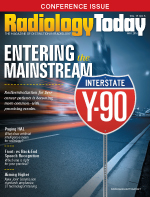 May 2016
May 2016
Guest Commentary: Changing Your Behavior — 5 Ways to Keep Your Team Safe From Radiation With Real-Time Dose Monitoring
By Chintan Shah
Radiology Today
Vol. 17 No. 5 P. 11
Prominent interventional physicians are speaking out to alert others about the significant and sometimes life-altering health risks they face as a result of chronic exposure to ionizing radiation. More than 500 people participated in a town hall-style discussion at the International Symposium on Endovascular Therapy in Hollywood, Florida, in February, to voice their concerns and share experiences about career-related health risks that impact a growing number of interventional teams, including physicians, nurses, and technologists.
Concern over the biological effects of ionizing radiation has only grown following the discovery of X-rays in 1895. In fact, ionizing radiation exposure in the United States rose a whopping 74% on a per-capita basis from the early 1980s to 2006, with nearly one-half of the exposure related to medical imaging, according to the FDA's Initiative to Reduce Unnecessary Radiation Exposure from Medical Imaging, launched in 2010. While technological developments have led to less invasive procedures for patients, innovation has quite possibly had adverse effects on the health of interventional physicians and their teams.
Sustained exposure to low-dose radiation from procedures performed daily over the course of a career may cause serious, long-term, and possibly fatal adverse health consequences. A substantial and growing body of evidence casts serious doubts on whether interventional medical professionals exposed to ionizing radiation are being adequately protected. This includes a February 2015 study published in Research in Cardiovascular Medicine and whitepapers released by the International Atomic Energy Agency and the Organization for Occupational Radiation Safety in Interventional Fluoroscopy.
There is no safe dose for radiation exposure, but there are established thresholds of acceptable exposure levels. Yet there is a growing incidence of medical conditions, such as cataract development, cancers, and brain tumors, linked to excessive radiation exposure. Although the effects of radiation are delayed, new studies highlight the sensitivity of the brain and eyes and how they are more susceptible to the effects of radiation than previously thought. Studies show that nurses, for example, have a 40% higher chance of developing cataracts if they work in the radiology suite.
In addition, severe musculoskeletal problems have been reported among interventionalists, as a result of wearing the lead gear that is standard protocol in fluoroscopy labs. The lead vests often result in disc compression over the course of a day, and the fatigue of wearing them throughout a career can result in serious skeletal issues. Robotics and mobile shielding can aid in finding a viable solution for protection.
Medical professionals acknowledge some culpability with regard to exposing themselves to excessive levels of radiation, since some admit to not consistently wearing dosimetry badges. Some estimates show overall adherence to wearing the badges at 19%. The issue, according to some physicians, is that people tend to worry about immediate dangers rather than potential dangers. Radiation exposure doesn't seem like an immediate danger to most physicians and clinical staff, until it becomes an obvious health problem.
The same innovation that has proven helpful for medical treatment is also proving to help all staff, from the interventional radiologist to the nurse and anesthesiologist, to see the immediate danger. Real-time dose monitoring gives a clear, visual indication of staff exposure levels on a monitor in the procedure room—green, yellow, or red signals—in real time so behaviors can be changed to proactively reduce dose.
So, what's the solution for protecting fluoroscopy lab teams from the harmful effects of ionizing radiation? The following are a few key suggestions highlighted by several organizations, regulatory guidelines, and the International Atomic Energy Agency's 10 Pearls.
• Proper shielding is the first line of defense against radiation exposure. Shielding can consist of lead vests to protect the body and lead caps to protect the head. Lead goggles are also important, to protect the eyes. Mobile shielding can also be maneuvered in a room where necessary.
• Radiation awareness and refresher training classes are important for all staff members. For example, during medical school, physicians are educated on many of the proper techniques and principals for radiation safety, including ALARA practices.
• Consider technological advances such as a real-time dosimetry system, a beneficial teaching tool that also reinforces proper procedures. Real-time insight about personal radiation exposure allows medical staff to immediately change behavior, in order to minimize radiation dose.
• Learn about the physics of scatter radiation and how to avoid overexposure to it, as well as the effect of the angulation of the C-arm.
• Practice a collaborative environment to inspire members of the radiological suite to work together for the benefit of the team. Communication and awareness efforts make for a collectively stronger and healthier team.
The harmful health effects of ionizing radiation develop over time so precautions must be taken and safety must be taught early and often. Support from hospital administration goes a long way to help support effective industry changes and new standard protocols to protect those working to protect patients.
— Chintan Shah is marketing and sales manager of personal dosimetry for Unfors RaySafe.

